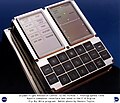Plik:Apollo display and keyboard unit (DSKY) used on F-8 DFBW DVIDS683588.jpg
Wygląd

Rozmiar podglądu – 765 × 600 pikseli. Inne rozdzielczości: 306 × 240 pikseli | 612 × 480 pikseli | 980 × 768 pikseli | 1280 × 1004 pikseli | 2560 × 2007 pikseli | 3030 × 2376 pikseli.
Rozmiar pierwotny (3030 × 2376 pikseli, rozmiar pliku: 6,18 MB, typ MIME: image/jpeg)
Historia pliku
Kliknij na datę/czas, aby zobaczyć, jak plik wyglądał w tym czasie.
| Data i czas | Miniatura | Wymiary | Użytkownik | Opis | |
|---|---|---|---|---|---|
| aktualny | 08:29, 9 paź 2021 |  | 3030 × 2376 (6,18 MB) | Huntster | Cropped 9 % vertically using CropTool with lossless mode. |
| 08:28, 9 paź 2021 |  | 3030 × 2606 (5,97 MB) | Huntster | Full resolution from NASA. | |
| 02:42, 6 maj 2015 |  | 1536 × 1321 (303 KB) | Fæ | == {{int:filedesc}} == {{milim | description = {{en|1=The display and keyboard (DSKY) unit used on the F-8 Digital Fly-By-Wire (DFBW) aircraft during Phase I of the fly-by-wire program. Warning lights are in the upper left section, displays in the uppe... |
Lokalne wykorzystanie pliku
Poniższa strona korzysta z tego pliku:
Globalne wykorzystanie pliku
Ten plik jest wykorzystywany także w innych projektach wiki:
- Wykorzystanie na ar.wikipedia.org
- Wykorzystanie na en.wikipedia.org
- Wykorzystanie na es.wikipedia.org
- Wykorzystanie na fi.wikipedia.org
- Wykorzystanie na fr.wikipedia.org
- Wykorzystanie na he.wikipedia.org
- Wykorzystanie na hu.wikipedia.org
- Wykorzystanie na ja.wikipedia.org
- Wykorzystanie na ru.wikipedia.org
- Wykorzystanie na uk.wikipedia.org


